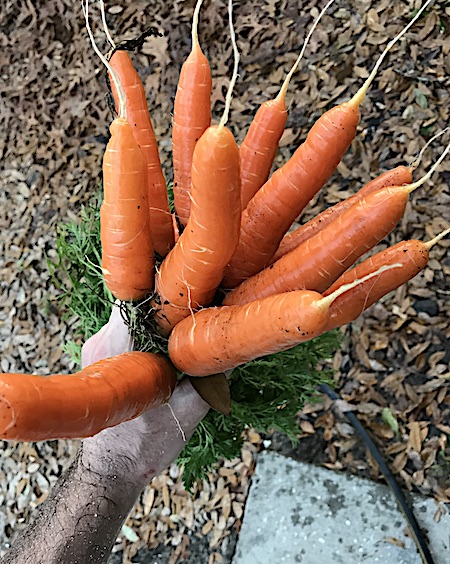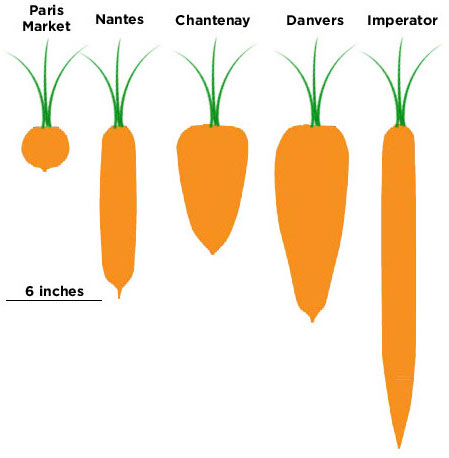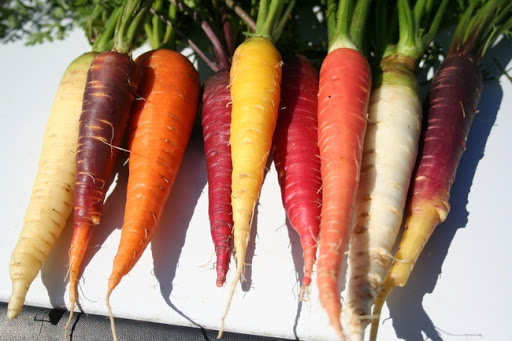What’s Up Doc? Growing Carrots Bugs Bunny Would Love
By Janet Scheren, Fairfax Master Gardener Intern
 It may be summer, but now is the time to get your carrots in a row and prepare for wonderful fall and winter eating. From salads, soups, stir fries, kimchee, crudité, stocks, purees and walking salads for hikes, to hearty stews and roasts, cakes and even pies, perhaps no other home crop proves so versatile.
It may be summer, but now is the time to get your carrots in a row and prepare for wonderful fall and winter eating. From salads, soups, stir fries, kimchee, crudité, stocks, purees and walking salads for hikes, to hearty stews and roasts, cakes and even pies, perhaps no other home crop proves so versatile.
Cultural Issues
Carrots are a relatively easy crop to grow, with few pests or diseases to worry about. This is a crop you will grow from seed and plant directly outdoors in a sunny spot. Carrots don’t transplant well.
There are three minor challenges to overcome in growing carrots: Spacing the extremely small seed uniformly to reduce thinning, ensuring sufficient moisture for the seed to germinate and providing well-drained deep loam soil that is completely free of rocks and other debris. This will produce the well-formed beautiful carrots that we are used to seeing and that Bugs would love.
The Virginia Cooperative Extension suggests mixing carrot seed with fine soil and lightly scattering the mixture in a row or bed/container to space plants out sufficiently. One way to provide the deep friable soil carrots need is to grow them in a container. Cloth grow bags work great as does any pot or bucket with sufficient drainage holes. Fill the container with moistened potting soil amended with compost, scatter the seeds on top and cover them with a dusting of fine soil. Water the soil well with the gentlest spray possible to avoid displacing the seeds. If planting in a bed, ensure you have well-enriched loam that is dug deeply and contains no obstructions to those developing roots.

Leafy and decorative in a container
They prefer their soil at a pH of 6.0 to 6.8 but will tolerate a wider range. Avoid nitrogen-heavy fertilizers and manures that promote bushy tops, but spindly roots. Nitrogen encourages leaf growth. You can aid root growth, however, by adding a little extra phosphorus in the form of bone meal and mixing it into the soil before seeding. Don’t overdo it.
Thinning and Weeding
No matter how carefully you spaced the seeds, you will likely still need to do some thinning. Carrots should be thinned to 2 inches apart, using a fine-tipped pair of scissors or a micro-tipped pruner to cut through the greens of weaker seedlings that are too close to others. This removes excess plants without disrupting or damaging the remaining seedlings and their roots.
It’s important to control weeds without disturbing the carrot roots until the plants are 12 inches high, because carrot seedlings are weak and grow slowly. Applying mulch, straw or shredded leaves can help control weeds while also retaining moisture in the soil.
You may already know that “carrots love tomatoes,” as the title of Louise Riotte’s best-selling book about the secrets of companion planning announces. The author also suggests growing carrots with leaf lettuce, chives, onions, leeks, radishes and herbs such as rosemary and sage. These companion plants help to repel the carrot fly whose larva can attack young plants.
When to Plant and When to Harvest
 Carrots are a cool weather crop. Except in years with extremely mild winters, carrot gardeners in our USDA Hardiness Zone 7a will have a fall and spring growing season. The spring planting window runs from about March 5 through April 25. Fall planting can begin as early as September 15 and run through October 25. This longer fall window allows for two successive carrot crops. These can run from as early as late October through the end of the year and make carrots available for both a Thanksgiving and Christmas harvest. As an added bonus to the fall crop, light frosts can make the carrots even sweeter.
Carrots are a cool weather crop. Except in years with extremely mild winters, carrot gardeners in our USDA Hardiness Zone 7a will have a fall and spring growing season. The spring planting window runs from about March 5 through April 25. Fall planting can begin as early as September 15 and run through October 25. This longer fall window allows for two successive carrot crops. These can run from as early as late October through the end of the year and make carrots available for both a Thanksgiving and Christmas harvest. As an added bonus to the fall crop, light frosts can make the carrots even sweeter.
Depending on the variety, carrots can take 55 to 80 days to reach maturity. They are typically harvested as needed when their roots reach one-half to three-fourths inch in diameter. According to a tip from a fellow master gardener, carrots can be left in the ground until the beginning of winter. They don’t continue to grow but will be kept fresh until needed.
Carrot Shapes and Colors
Carrots come in many shapes and colors. Key carrot shapes include:
- Chantenay — Up to 5 inches, wide at the top and tapering
- Danvers — Up to 7 inches long, slender, but wider at the top than the Imperator types and have strong flavor
- Imperator — Up to 10 inches long, slender
- Nantes — Up to 7 inches long, more cylindrical than tapered, sweet flavor. Also known as half-long carrots
 Colors run from deep purple to red, the typical orange, yellow and white. Some seed packets contain a mix of colors. One master gardener has had great success with Nantes-shaped (half-long) carrots in Virginia. He suggests selecting two or three individual varieties rather than planting a mix, because the mix might contain more of a variety you don’t like.
Colors run from deep purple to red, the typical orange, yellow and white. Some seed packets contain a mix of colors. One master gardener has had great success with Nantes-shaped (half-long) carrots in Virginia. He suggests selecting two or three individual varieties rather than planting a mix, because the mix might contain more of a variety you don’t like.
Resources
Root Crops: Carrots, Virginia Cooperative Extension Publication 426-422
Growing Guide: Carrots, Cornell University
Virginia’s Home Garden Vegetable Planting Guide, Virginia Cooperative Extension Publication No. 426-331
Planning the Vegetable Garden, Virginia Cooperative Extension Publication No. 426-312
Carrots Love Tomatoes, Secrets of Companion Planting for Successful Gardening, by Louise Riotte, 1998